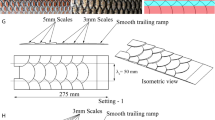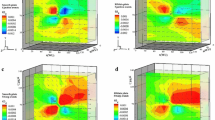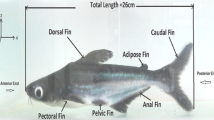Abstract
Sharks can swim with excellent hydrodynamic performance under a variety of flow conditions. The dermal scales of sharks, which can change from an aligned state to a tilted state, account for flow control in the attached and separated flow. However, the mechanism of using tilted biomimetic shark scales for flow separation control is still not clear. In the present work, the effects of biomimetic shark scales with fixed tilt angles on flow separation over an inclined plate are investigated experimentally using time-resolved particle image velocimetry. The Reynolds number based on the streamwise length of the plate and the freestream velocity is 2.0 × 104. From the perspective of the time-averaged flow field, it is found that the tilted biomimetic shark scales decrease the reattachment length by 57% when the angle of attack of the plate is 10°. From the perspective of the instantaneous flow field, the shed vortices over the tilted biomimetic shark scales are closer to the wall than those over the flat plate. The fluid convection is strengthened in the separated shear layer by the tilted biomimetic shark scales, as the momentum transportation and the vorticity convection are enhanced. As a result, normal motions of fluid in the separated shear layer are improved, and energy is supplied to resist flow separation. A flow separation control strategy is proposed for different tilt angles of the biomimetic shark scales and angles of attack, which is significant for engineering applications involving flow control.
Graphical abstract











Similar content being viewed by others
References
Akbarzadeh AM, Borazjani I (2019) Reducing flow separation of an inclined plate via travelling waves. J Fluid Mech 880:831–863. https://doi.org/10.1017/jfm.2019.705
Arunvinthan S, Raatan VS, Pillai SN, Pasha AA, Rahman MM, Juhany KA (2021) Aerodynamic characteristics of shark scale-based vortex generators upon symmetrical airfoil. Energies 14:1808. https://doi.org/10.3390/en14071808
Bearman PW, Harvey JK (1993) Control of circular cylinder flow by the use of dimples. AIAA J 31:1753–1756. https://doi.org/10.2514/3.11844
Bechert DW, Bruse M, Hage W, Van der Hoeven JCT, Hoppe G (1997) Experiments on drag-reducing surfaces and their optimization with an adjustable geometry. J Fluid Mech 338:59–87. https://doi.org/10.1017/S0022112096004673
Bechert DW, Bruse M, Hage W, Meyer R (2000) Fluid mechanics of biological surfaces and their technological application. Naturwissenschaften 87:157–171. https://doi.org/10.1007/s001140050696
Bixler GD, Bhushan B (2013) Fluid drag reduction with shark-skin riblet inspired microstructured surfaces. Adv Funct Mater 23:4507–4528. https://doi.org/10.1002/adfm.201203683
Bullee PA, Verschoof RA, Bakhuis D, Huisman SG, Sun C, Lammertink RGH, Lohse D (2020) Bubbly drag reduction using a hydrophobic inner cylinder in Taylor-Couette turbulence. J Fluid Mech 883:A61. https://doi.org/10.1017/jfm.2019.894
Chao L, Cao Y, Pan G (2017) A review of underwater bio-mimetic propulsion: cruise and fast-start. Fluid Dyn Res 49:044501. https://doi.org/10.1088/1873-7005/aa6a66
Cho S, Kim J, Choi H (2018) Control of flow around a low Reynolds number airfoil using longitudinal strips. Phys Rev Fluids 3:113901. https://doi.org/10.1103/PhysRevFluids.3.113901
Choi J, Jeon W-P, Choi H (2006) Mechanism of drag reduction by dimples on a sphere. Phys Fluids 18:041702. https://doi.org/10.1063/1.2191848
Choi H, Jeon W-P, Kim J (2008) Control of flow over a bluff body. Annu Rev Fluid Mech 40:113–139. https://doi.org/10.1146/annurev.fluid.39.050905.110149
Crane RJ, Popinhak AR, Martinuzzi RJ, Morton C (2022) Tomographic PIV investigation of vortex shedding topology for a cantilevered circular cylinder. J Fluid Mech 931:R1. https://doi.org/10.1017/jfm.2021.904
DeVoria AC, Mohseni K (2015) Vortex structure of low-aspect-ratio wings in sideslip. In: Proceedings of the AIAA aerospace sciences meeting (Kissimmee, FL, USA) https://doi.org/10.2514/6.2015-1273
DeVoria AC, Mohseni K (2017) On the mechanism of high-incidence lift generation for steadily translating low-aspect-ratio wings. J Fluid Mech 813:110–126. https://doi.org/10.1017/jfm.2016.849
Domel AG, Saadat M, Weaver JC, Haj-Hariri H, Bertoldi K, Lauder GV (2018) Shark skin-inspired designs that improve aerodynamic performance. J R Soc Interface 15:20170828. https://doi.org/10.1098/rsif.2017.0828
Du Clos KT, Lang A, Devey S, Motta PJ, Habegger ML, Gemmell BJ (2018) Passive bristling of mako shark scales in reversing flows. J R Soc Interface 15:20180473. https://doi.org/10.1098/rsif.2018.0473
Evans HB, Hamed AM, Gorumlu S, Doosttalab A, Aksak B, Chamorro LP, Castillo L (2018) Engineered bio-inspired coating for passive flow control. Proc Natl Acad Sci USA 115:1210–1214. https://doi.org/10.1073/pnas.1715567115
Feng L, Choi K, Wang J (2015) Flow control over an airfoil using virtual Gurney flaps. J Fluid Mech 767:595–626. https://doi.org/10.1017/jfm.2015.22
Fish FE, Lauder GV (2006) Passive and active flow control by swimming fishes and mammals. Annu Rev Fluid Mech 38:193–224. https://doi.org/10.1146/annurev.fluid.38.050304.092201
Gad-el-Hak M, Bushnell DM (1991) Separation control: review. J Fluids Eng-Trans ASME 113:5–30. https://doi.org/10.1115/1.2926497
Glezer A, Amitay M (2002) Synthetic jets. Annu Rev Fluid Mech 34:503–529. https://doi.org/10.1146/annurev.fluid.34.090501.094913
Goldstein D, Handler R, Sirovich L (1995) Direct numerical simulation of turbulent flow over a modelled riblet covered surface. J Fluid Mech 302:333–376. https://doi.org/10.1017/S0022112095004125
Guo P, Zhang K, Yasuda Y, Yang W, Galipon J, Rival DE (2021) On the influence of biomimetic shark skin in dynamic flow separation. Bioinspir Biomim 16:034001. https://doi.org/10.1088/1748-3190/abdf31
Jeong J, Hussain F (1995) On the identification of a vortex. J Fluid Mech 285:69–94. https://doi.org/10.1017/S0022112095000462
Jones G, Santer M, Debiasi M, Papadakis G (2018) Control of flow separation around an airfoil at low Reynolds numbers using periodic surface morphing. J Fluids Struct 76:536–557. https://doi.org/10.1016/j.jfluidstructs.2017.11.008
Jullien M-C (2003) Dispersion of passive tracers in the direct enstrophy cascade: experimental observations. Phys Fluids 15:2228. https://doi.org/10.1063/1.1585030
Kähler CJ, Scholz U, Ortmanns J (2006) Wall-shear-stress and near-wall turbulence measurements up to single pixel resolution by means of long-distance micro-PIV. Exp Fluids 41:327–341. https://doi.org/10.1007/s00348-006-0167-0
Kirk TM, Yarusevych S (2017) Vortex shedding within laminar separation bubbles forming over an airfoil. Exp Fluids 58:43. https://doi.org/10.1007/s00348-017-2308-z
Kiya M, Sasaki K (1983) Structure of a turbulent separation bubble. J Fluid Mech 137:83–113. https://doi.org/10.1017/S002211208300230X
Lang A, Bradshaw MT, Smith JA, Wheelus JN, Motta PJ, Habegger ML, Hueter RE (2014) Movable shark scales act as a passive dynamic micro-roughness to control flow separation. Bioinspir Biomim 9:036017. https://doi.org/10.1088/1748-3182/9/3/036017
Lauder GV, Wainwright DK, Domel AG, Weaver JC, Wen L, Bertoldi K (2016) Structure, biomimetics, and fluid dynamics of fish skin surfaces. Phys Rev Fluids 1:060502. https://doi.org/10.1103/PhysRevFluids.1.060502
Lee S-J, Lee S-H (2001) Flow field analysis of a turbulent boundary layer over a riblet surface. Exp Fluids 30:153–166. https://doi.org/10.1007/s003480000150
Lee J, Kim H, Park H (2018) Effects of superhydrophobic surfaces on the flow around an NACA0012 hydrofoil at low Reynolds numbers. Exp Fluids 59:111. https://doi.org/10.1007/s00348-018-2564-6
Li W, Roggenkamp D, Hecken T, Jessen W, Klaas M, Schröder W (2018) Parametric investigation of friction drag reduction in turbulent flow over a flexible wall undergoing spanwise transversal traveling waves. Exp Fluids 59:105. https://doi.org/10.1007/s00348-018-2559-3
Li H, Ji S, Tan X, Li Z, Xiang Y, Lv P, Duan H (2020a) Effect of Reynolds number on drag reduction in turbulent boundary layer flow over liquid-gas interface. Phys Fluids 32:122111. https://doi.org/10.1063/5.0027727
Li H, Li Z, Tan X, Wang X, Huang S, Xiang Y, Lv P, Duan H (2020b) Three-dimensional backflow at liquid–gas interface induced by surfactant. J Fluid Mech 899:A8. https://doi.org/10.1017/jfm.2020.426
Li H, Cao Y, Wang X, Wan X, Xiang Y, Yuan H, Lv P, Duan H (2022) Accurate PIV measurement on slip boundary using single-pixel algorithm. Meas Sci Technol 33:055302. https://doi.org/10.1088/1361-6501/ac42b1
Lv P, Xue Y, Shi Y, Lin H, Duan H (2014) Metastable states and wetting transition of submerged superhydrophobic structures. Phys Rev Lett 112:196101. https://doi.org/10.1103/PhysRevLett.112.196101
Mancini P, Manar F, Granlund K, Ol MV, Jones AR (2015) Unsteady aerodynamic characteristics of a translating rigid wing at low Reynolds number. Phys Fluids 27:123102. https://doi.org/10.1063/1.4936396
Mao Q, Wang P, He C, Liu Y (2021) Unsteady flow structures behind a shark denticle replica on the wall: time-resolved particle image velocimetry measurements. Phys Fluids 33:075109. https://doi.org/10.1063/5.0057699
Motta PJ, Habegger ML, Lang A, Hueter RE, Davis J (2012) Scale morphology and flexibility in the shortfin mako Isurus oxyrinchus and the blacktip shark Carcharhinus limbatus. J Morphol 273:1096–1110. https://doi.org/10.1002/jmor.20047
Mueller TJ, DeLaurier JD (2003) Aerodynamics of small vehicles. Annu Rev Fluid Mech 35:89–111. https://doi.org/10.1146/annurev.fluid.35.101101.161102
Park H, Choi C-H, Kim C-J (2021) Superhydrophobic drag reduction in turbulent flows: a critical review. Exp Fluids 62:229. https://doi.org/10.1007/s00348-021-03322-4
Ran W, Zare A, Jovanović MR (2021) Model-based design of riblets for turbulent drag reduction. J Fluid Mech 906:A7. https://doi.org/10.1017/jfm.2020.722
Rashidi S, Hayatdavoodi M, Esfahani JA (2016) Vortex shedding suppression and wake control: a review. Ocean Eng 126:57–80. https://doi.org/10.1016/j.oceaneng.2016.08.031
Rival D, Prangemeier T, Tropea C (2009) The influence of airfoil kinematics on the formation of leading-edge vortices in bio-inspired flight. Exp Fluids 46:823–833. https://doi.org/10.1007/s00348-008-0586-1
Santos LM, Lang A, Wahidi R, Bonacci A, Gautam S, Devey S, Parsons J (2021) Passive separation control of shortfin mako shark skin in a turbulent boundary layer. Exp Therm Fluid Sci 128:110433. https://doi.org/10.1016/j.expthermflusci.2021.110433
Sooraj P, Ramagya MS, Khan MH, Sharma A, Agrawal A (2020) Effect of superhydrophobicity on the flow past a circular cylinder in various flow regimes. J Fluid Mech 897:A21. https://doi.org/10.1017/jfm.2020.371
Thielicke W, Stamhuis EJ (2014) PIVlab–towards user-friendly, affordable and accurate digital particle image velocimetry in MATLAB. J Open Res Soft 2:e30. https://doi.org/10.5334/jors.bl
Tian G, Fan D, Feng X, Zhou H (2021) Thriving artificial underwater drag-reduction materials inspired from aquatic animals: progresses and challenges. RSC Adv 11:3399–3428. https://doi.org/10.1039/D0RA08672J
Toloui M, Abraham A, Hong J (2019) Experimental investigation of turbulent flow over surfaces of rigid and flexible roughness. Exp Therm Fluid Sci 101:263–275. https://doi.org/10.1016/j.expthermflusci.2018.10.026
Veerakumar R, Raul V, Liu Y, Wang X, Leifsson L, Hu H (2020) Metamodeling-based parametric optimization of DBD plasma actuation to suppress flow separation over a wind turbine airfoil model. Acta Mech Sin 36:260–274. https://doi.org/10.1007/s10409-020-00951-6
Wainwright SA, Vosburgh F, Hebrank JH (1978) Shark skin: function in locomotion. Science 202:747–749. https://doi.org/10.1126/science.202.4369.747
Wallace JM (2016) Quadrant analysis in turbulence research: history and evolution. Annu Rev Fluid Mech 48:131–158. https://doi.org/10.1146/annurev-fluid-122414-034550
Wen L, Weaver JC, Lauder GV (2014) Biomimetic shark skin: design, fabrication and hydrodynamic function. J Exp Biol 217:1656–1666. https://doi.org/10.1242/jeb.097097
Wen L, Weaver JC, Thornycroft PJM, Lauder GV (2015) Hydrodynamic function of biomimetic shark skin: effect of denticle pattern and spacing. Bioinspir Biomim 10:066010. https://doi.org/10.1088/1748-3190/10/6/066010
Wu Y, Christensen KT (2006) Population trends of spanwise vortices in wall turbulence. J Fluid Mech 568:55–76. https://doi.org/10.1017/S002211200600259X
Xiang Y, Huang S, Lv P, Xue Y, Su Q, Duan H (2017) Ultimate stable underwater superhydrophobic state. Phys Rev Lett 119:134501. https://doi.org/10.1103/PhysRevLett.119.134501
Xiang Y, Huang S, Huang T, Dong A, Cao D, Li H, Xue Y, Lv P, Duan H (2020) Superrepellency of underwater hierarchical structures on Salvinia leaf. Proc Natl Acad Sci USA 117:2282–2287. https://doi.org/10.1073/pnas.1900015117
Zhu J, Zhu F, Su W, Zou S, Liu L, Shi Y, Wu J (2014) A vorticity dynamics view of “effective slip boundary” with application to foil flow control. Phys Fluids 26:123602. https://doi.org/10.1063/1.4904379
Acknowledgements
This work is supported by the National Natural Science foundation of China (NSFC) under grants Nos. 11988102, 11872004, U2141251, 91848201, 12172006, 12002007, and Wenhai Program of the S&T Fund of Shandong Province for Pilot National Laboratory for Marine Science and Technology (Qingdao) Grant No. 2021WHZZB2000. The authors thank S. Zou, W. Su, Y. Zhang, and Z. Huang for valuable discussions. The characterization of the real shark specimen by the micro-CT scanner was conducted at the Department of Mechanics and Engineering Science of Peking University by J. Chen.
Author information
Authors and Affiliations
Contributions
Z. Du and H. Duan designed the research; Z. Du, H. Li, X. Wan, and P. Lv performed the experiment; Z. Du, Y. Cao, and Y. Xiang analyzed the data; and Z. Du, H. Li, P. Lv, and H. Duan wrote the paper.
Corresponding author
Additional information
Publisher’s Note
Springer Nature remains neutral with regard to jurisdictional claims in published maps and institutional affiliations.
Rights and permissions
Springer Nature or its licensor holds exclusive rights to this article under a publishing agreement with the author(s) or other rightsholder(s); author self-archiving of the accepted manuscript version of this article is solely governed by the terms of such publishing agreement and applicable law.
About this article
Cite this article
Du, Z., Li, H., Cao, Y. et al. Control of flow separation using biomimetic shark scales with fixed tilt angles. Exp Fluids 63, 158 (2022). https://doi.org/10.1007/s00348-022-03517-3
Received:
Revised:
Accepted:
Published:
DOI: https://doi.org/10.1007/s00348-022-03517-3




